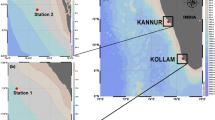Abstract
Analyses of moored current meter data from the South China Sea (SCS) Coastal Oceanographic Process Experiment Pilot Project (SCOPE-PP) reveal that strong spatial variation in the vertical structure of coastal currents in the northern SCS (NSCS) was caused by the interaction between the Pearl River plume (PRP) and the alongshore coastal jet. Observations indicate that the NSCS coastal current was generally eastward, spreading the PRP water eastward. The lighter brackish plume residing on the top of the saline, coastal water strengthened the stratification near the surface and blocked the downward momentum transport, resulting in a strong vertical shear of the velocity at the mooring site S205. Meanwhile, the plume water raised the sea level. Because of the geostrophic balance in the across-shore direction, the eastward coastal current in the upper layer strengthened on the onshore side (near S205) and weakened on the offshore side (near S206 and S305) due to the plume water intrusion. Therefore, the vertical shear of the velocity was enhanced at S205 and reduced at S206 and S305. Moreover, because the plume varied substantially with the wind, the vertical shear of the velocity responding to the wind was different between S205 and S206. The numerical simulation during summer 2008 confirms that the PRP enhances (weakens) the vertical shear of the velocity on the onshore (offshore) side by increasing (decreasing) the upper-layer current by about 0.2 m s-1 and decreasing (increasing) the middle-layer current slightly.








Similar content being viewed by others
References
Blumberg AF, Mellor GL (1987) A description of a three-dimensional coastal ocean circulation model. In: Heaps N (ed) Three-dimensional Coastal Ocean Models, Coastal Estuarine Study, vol 4. AGU, Washington, D.C., pp 1–16
Boyer T, Levitus S, Garcia H, Locarnini R, Stephens C, Antonov J (2005) Objective analyses of annual, seasonal, and monthly temperature and salinity for the World Ocean on a 0.25 grid. J Clim 25:931–945
Chant RJ, Glenn SM, Hunter E, Kohut J, Chen RF, Houghton RW, Bosch J, and Schofield O 2008 Bulge formation of a buoyant river outflow.Journal of Geophysical Research 113(C01017), doi:10.1029/2007JC004100
Chao SY (1988) Wind-driven motion of estuarine plumes. J Phys Oceanogr 18:1144–1166
Chu PC, Edmons NL, Fan CW (1999) Dynamical mechanisms for the South China Sea seasonal circulation and thermohaline variabilities. J Phys Oceanogr 29:2971–2989
Gan JP, Li L, Wang D, Guo X (2009a) Interaction of a river plume with coastal upwelling in the northeastern South China Sea. Cont Shelf Res 29(4):728–740. doi:10.1016/j.csr.2008.12.002
Gan JP, Cheung A, Guo XG, Li L 2009b Intensified upwelling over a widened shelf in the northeastern South China Sea. Journal of Geophysical Research 114, C09019, doi:10.1029/2007JC004660
Guan BX, Fang G (2006) Winter counter-wind currents off the southeastern China coast: a review. J Oceanogr 62:1–24
Hu J, Kawamura H, Hong H, Qi Y 2000 A review on the currents in the South China Sea: seasonal circulation, South China Sea Warm Current and Kuroshio intrusion. J Oceanogr 56:607–624. Continental Shelf Research, 24, 1745–1760
Lentz SJ (2001) The influence of stratification on the wind-driven cross-shelf circulation over the north Carolina shelf. J Phys Oceanogr 23:2749–2760
Ou S, Zhang H, Wang D (2009) Dynamics of the buoyant plume off the Pearl River Estuary in summer. Environ Fluid Mech 9:471–492
Rennie SE, Largier JL, Lentz SJ (1999) Observations of a pulsed buoyancy current downstream of Chesapeake Bay. J Geophys Res 104:18,227–18,240
Shu Y, Wang D, Zhu J, Peng S (2011) The 4-D structure of upwelling and Pearl River plume in the northern South China Sea during summer 2008 revealed by a data assimilation model. Ocean Model 36:228–241
Su J (2004) Overview of the South China Sea circulation and its influence on the coastal physical oceanography outside the Pearl River Estuary. Cont Shelf Res 24:1745–1760
Sun Z, Hu J, Zheng Q, Li C (2011) Strong near-inertial oscillations in geostrophic shear in the northern South China Sea. J Oceanogr 67:377–384. doi:10.1007/s10872-011-0038-z
Wang D, Xu H, Lin J, Hu J (2008) Anticyclonic eddies in the northeastern South China Sea during winter 2003/2004. J Oceanogr 64(6):925–935
Wang D, Hong B, Gan J, Xu H (2010) Numerical investigation on propulsion of the counter-wind current in the northern South China Sea in winter. Deep-Sea Res I 57:1206–1221
Wang D, SHU Y, Xue H et al (2014) Relative contributions of local wind and topography to the coastal upwelling in the northern South China Sea. J Geophys Res -Oceans 119(4):2550–2567
Wyrtki K 1961. Physical oceanography of the southeast Asian waters: Scientific results of marine investigations of the South China Sea and the Gulf of Thailand, NAGA Rep. 2, 195 pp., Scripps Inst. of Oceanogr., La Jolla, Calif
Xue H, Chai F, Pettigrew N, Xu D, Shi M, Xu J (2004) Kuroshio intrusion and the circulation in the South China Sea. J Geophys Res 109, C02017. doi:10.1029/2002JC001724
Yin L, Qiao F, Zheng Q (2013) Coastal trapped waves in the East China Sea observed by a mooring array in winter 2006. J Phys Oceanogr 44:576–590
Zhang Z, Zhao W, Tian J, Liang X (2013) A mesoscale eddy pair southwest of Taiwan and its influence on deep circulation. J Geophys Res: Oceans 118:6479–6494. doi:10.1002/2013JC008994
Acknowledgments
This work is supported by the Ministry of Science and Technology (2011CB403504), the CAS (XDA10010405), the NSFC (No. 41476012), the General Research Fund of Hong Kong Research Grants Council under grants CUHK 402912 and 403113, and the SCSIO (No. SQ201001). The authors thank the SCOPE-PP cruise in July 2008, co-organized by Profs. J. Zhu, J.Y. Hu, X.G. Guo, M.H. Dai, and J.P. Gan. We also thank two anonymous reviewers for their helpful comments.
Author information
Authors and Affiliations
Corresponding author
Additional information
Responsible Editor: Pierre De Mey
Rights and permissions
About this article
Cite this article
Shu, Y., Chen, J., Yao, J. et al. Effects of the Pearl River plume on the vertical structure of coastal currents in the Northern South China Sea during summer 2008. Ocean Dynamics 64, 1743–1752 (2014). https://doi.org/10.1007/s10236-014-0779-5
Received:
Accepted:
Published:
Issue Date:
DOI: https://doi.org/10.1007/s10236-014-0779-5




